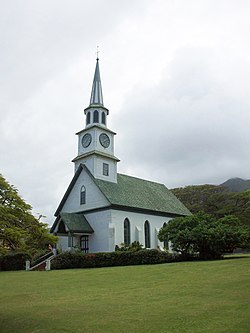Kaahumanu Church
|
Kaʻahumanu Church
|
|

Shown from north-eastern elevation, March 2010
|
|
| Location | 103 S. High St. Wailuku, Maui HI |
|---|---|
| Coordinates | 20°53′49″N 156°30′01″W / 20.89694°N 156.50028°WCoordinates: 20°53′49″N 156°30′01″W / 20.89694°N 156.50028°W |
| Area | 1.96 acres (7,900 m2) |
| Built | 1876 (Fourth and Current Structure) |
| Architectural style | New England Simple Style Gothic Architecture |
| NRHP Reference # | 75000622 |
| Added to NRHP | May 12, 1975 |
Kaʻahumanu Church is a Church in Wailuku, Maui, Hawaii. Upon visiting a religious service in Wailuku in 1832 by Jonathan Smith Green, Queen Ka'ahumanu requested that a more permanent church structure be named for her, but her request was not honored until 1876 when the current structure was built by Edward Bailey. Sunday services are held in the church, with the hymns and invocation invoked in the Hawaiian language.
Upon arrival to the islands, American Missionaries usually held religious services out in the open; this was later superseded by the building of thatched grassed , and then lumber built structures, sometimes imported from New England. The utilization of local materials became more prevalent over time
In 1832, Queen Ka'ahumanu, an early convert into Christianity, visited Maui, and came to the site of the then new Ka'ahumanu Church, witnessing services being presided by Jonathan Smith Green. Upon seeing this, Queen Ka'ahumanu asked the Congregationalist mission to name the permanent church structure after her.
The first building used by Jonathan Smith Green for his services was nothing more than a simple shed; it was built on land owned by Kahale family granted under King Kamehameha III.
In 1834, due to the ballooning congregation numbers (3000 worshipers was noted at one point) a second building was built, which was a thatched structure. However, despite the large worship numbers, the actual permanent membership of the church was small; an 1834-1835 report noted eleven members of the church.
During the "Great Revival" between 1837–1840, the church membership ballooned to 487; the 1838-1839 year alone saw 200 new members into the church. With this swell in membership, a new third church structure was built under the supervision of Richard Armstrong after Jonathan Smith Green left in 1836. Built in 1840, the "two-story" (One floor and a gallery) stone church was 100 by 52 feet (30 by 16 m). However, problems with the roof was noted by Jonathan Smith Green after his return in 1841 to replace Richard Armstrong. Deemed a "failure" by Jonathan Smith Green, the roof was fixed after a $648.28 expenditure.
...
Wikipedia

